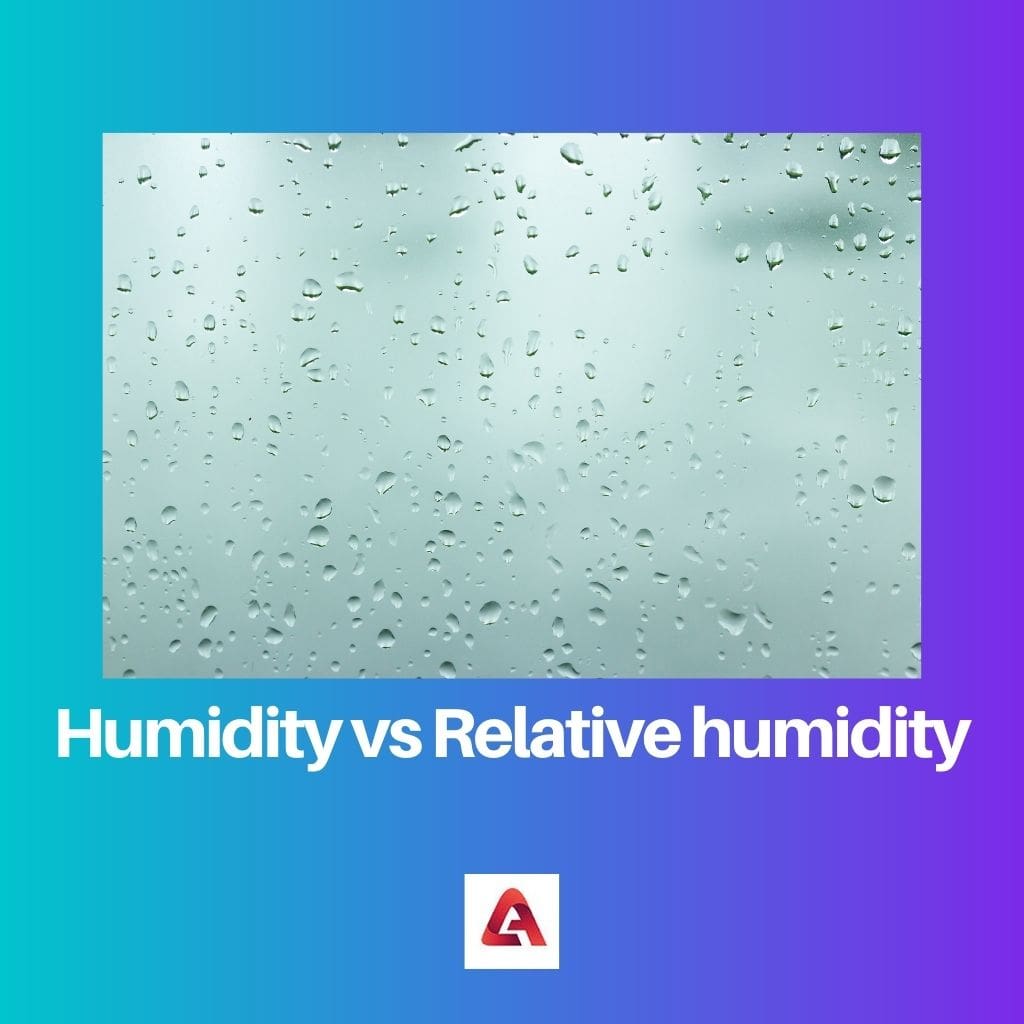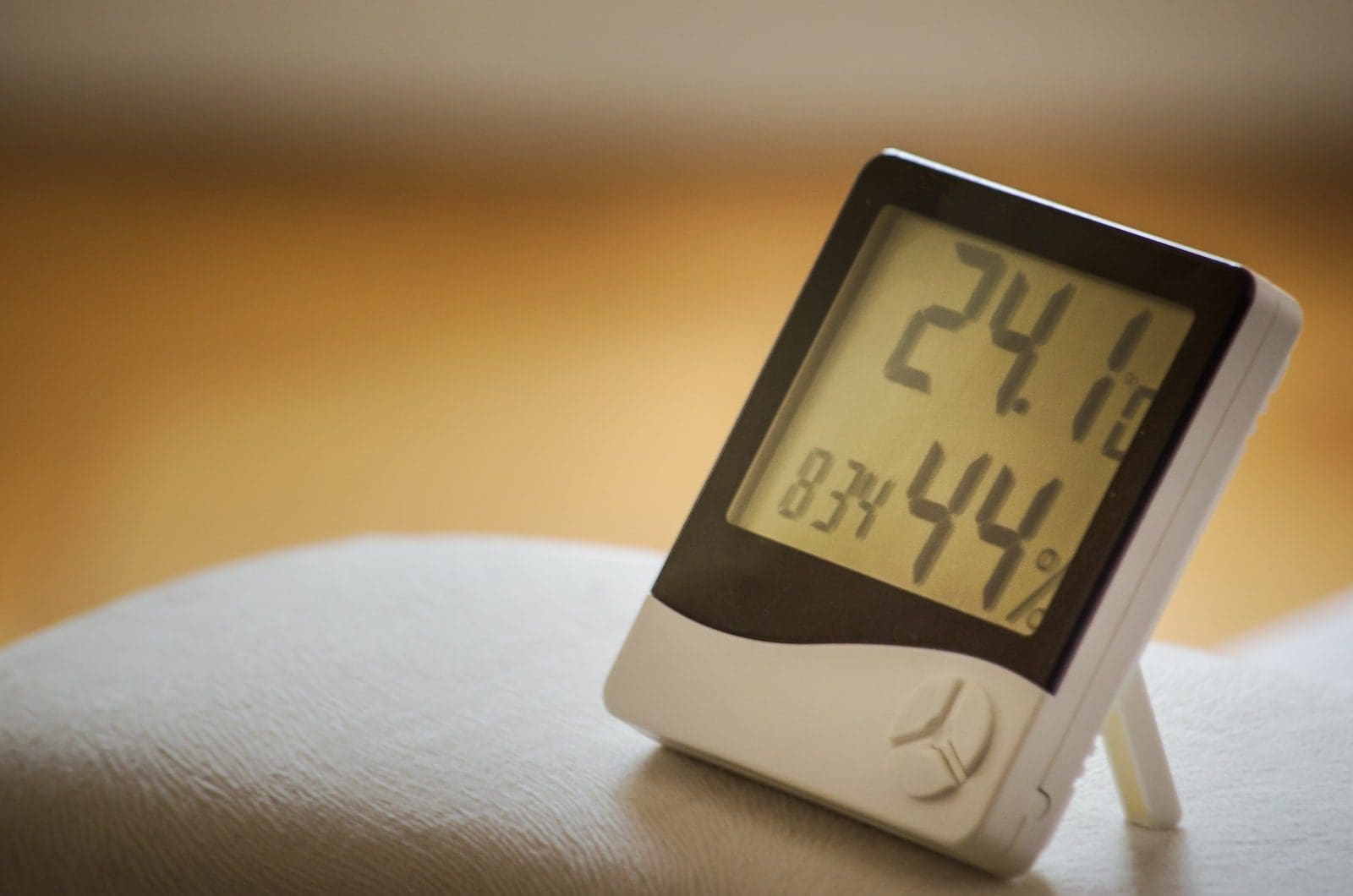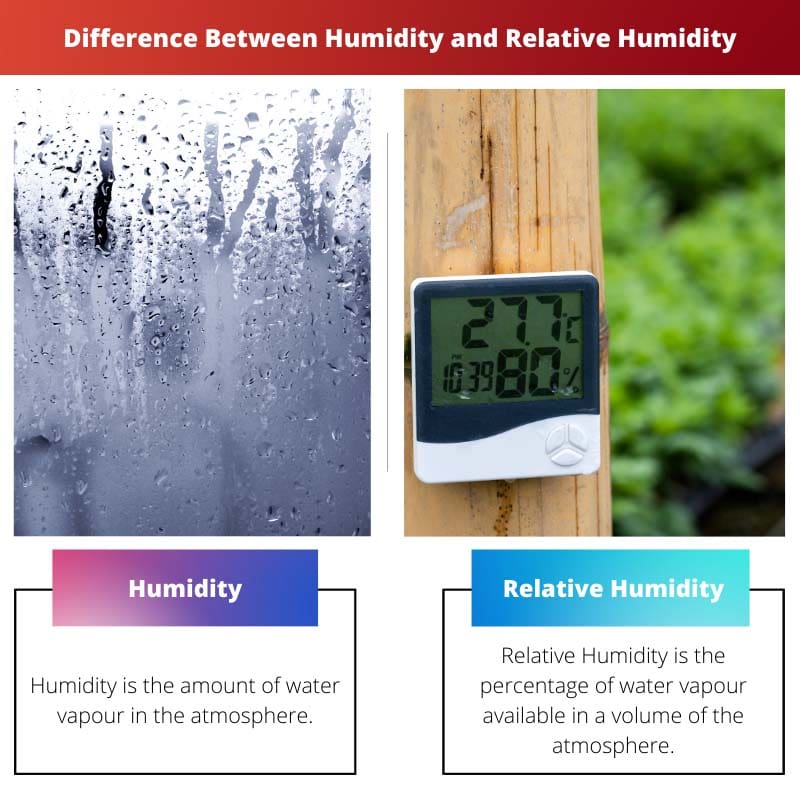The Weather and Climatic conditions of a place highly depend on the humidity in the atmosphere. The term humidity is connected to solar radiation and evaporation as well.
Key Takeaways
- Humidity refers to the amount of water vapor in the air and is important in determining how comfortable or uncomfortable the air feels.
- The relative humidity is a percentage measurement that compares the current humidity level to the maximum amount of water vapor the air can hold at a specific temperature.
- Understanding both humidity and relative humidity can help people make informed decisions about indoor comfort, weather forecasts, and the impact of humidity on various activities.
Humidity vs Relative Humidity
Humidity is the amount of water vapor in the air, which determines the fog, rain, and dew of a place. Relative humidity is the amount of water vapor present in the air and is depicted as a percentage of the amount of saturation needed in the air at the same temperature. It is abbreviated as RH.

Humidity is a terminology referring to the water vapour in the air. It regulates the earth’s heat and keeps living beings surviving without complications.
In simpler words, it is due to the humidity that we sweat and not because of the surrounding heat. More importantly, places close to the sea and water bodies are considered more humid than continental locations.
Continental Locations: These are the places that are landlocked and are not near any water body.
It can also be observed that the places near the seashore, called Tropical locations, are prone to moderate temperatures. At the same time, the continental locations have extreme temperatures.
In humidity, many related terminologies are used in determining the temperature and weather forecast. One of the most common terms is Relative Humidity.
Comparison Table
| Parameters of Comparison | Humidity | Relative humidity |
|---|---|---|
| Meaning | Humidity is the amount of water vapour in the atmosphere. | Relative Humidity is the percentage of water vapour available in a volume of the atmosphere at a given temperature. |
| Usage | Humidity is used to predict precipitation, fog or dew. | Relative Humidity is used to determine the change in weather conditions |
| Comparison | Humidity can be compared with the previous year’s data to predict the rain. | Relative Humidity is a comparison factor between the actual water vapour content and the water vapour content that can exist at that temperature. |
| Measuring Unit | Water Vapour per Cubic meter of air. | It is denoted in percentage. |
| Water Vapour Content | More Water Vapour, More Sweat, less water vapour, a lot cooler | More Water Vapour results in Higher Relative Humidity, and less water vapour results in less relative humidity. |
What is Humidity?
Humidity is the amount of water vapour that is present in the air. The humidity determines the rain, fog and dew factors of the place.
Ideally, it is a cyclic process. The solar radiation in the air results n the evaporation of water from the water bodies.
This evaporation results in water vapour and gets mixed in the air.
The air is already mixed with other gases and elements, and the water vapour combined with the atmosphere results in the overall weather condition of the place. If the solar radiation is more, or in other words, if the place experiences excessive heat, more evaporation happens.
This result is more water vapour getting mixed in the air.
This increases the precipitation levels. In some instances, you may experience excessive rainfall too. Have you ever noticed that you may encounter rain in the evening whenever a place has more temperature?
It is indeed a cyclic process that keeps living beings intact. The body sweat happens due to the humid conditions cooling the body from the heat.
Though sweat is undesirable, it is what helps humans to survive excessive heat as well.

What is Relative Humidity?
Relative Humidity, or RH, is the ratio of water vapour present in the atmosphere. The balance is measured against the water vapour that can be present at that given temperature.
Relative Humidity is measured in percentage, giving the value for the place to experience more humid conditions. More the value, the more the humidity and resultant sweat.
The tropical conditions have higher RH. The value can be seen in the weather forecast, which talks about the humidity levels. The relative humidity is calculated as follows:
Suppose 1 Volume of air can contain 100 grams of water vapour. But it has 50 grams of Water vapour then the RH is 50%.
Incidentally, the Relative Humidity is higher for Cold air and lower for warmer atmosphere. The RH is temperature specific and tends to change with temperature changes too.
Relative humidity being the measure, it is an essential aspect to determine the weather changes. This is also useful for checking the room temperature and also set your interiors accordingly.
Especially when you are placing certain things for a very long time, RH is the most critical component.
For example, if you place a set of books in a room, the RH value and relative changes you make can make the books survive longer.

Main Differences Between Humidity and Relative Humidity
- The main difference between humidity and relative humidity is the amount of water vapour in the air. In contrast, Relative humidity is the measure of water vapour present in a volume of air. It is the ratio of the actual water vapour to the water vapour that it can contain in the air volume.
- Humidity predicts atmospheric changes such as rain, fog and dew, while Relative Humidity measures humidity in a particular region.
- Humidity is also compared with the previous year’s data to predict rain and other environmental changes. At the same time, Relative Humidity compares the available water vapour and the actual water vapour that the air can contain.
- Humidity is measured in Water Vapour per cubic meter, whereas RH is measured in percentage.
- More Water Vapour in Air causes more precipitation and vice versa, while more RH denotes cooler weather and less RH indicates warm weather.


The post’s emphasis on the impact of solar radiation and evaporation on humidity, leading to a detailed explanation of RH, is enlightening and provides a deeper understanding of these atmospheric elements.
I completely agree, King Liam. This post offers a comprehensive understanding of the intricate relationship between atmospheric factors and humidity.
This is a great explanation of humidity and relative humidity and how it affects the climate of a place. It’s interesting to see how solar radiation and evaporation play a key role in determining the level of humidity in the atmosphere.
I completely agree, Pknight. This post provides a comprehensive and detailed explanation of humidity and relative humidity, which is very informative.
The detailed explanation of humidity and relative humidity in this post provides a comprehensive understanding of their significance in the weather and climate of different places.
Absolutely, Jdavies. It’s essential to comprehend these concepts to gauge the impact of humidity on the environment.
The post effectively elucidates the cyclic process of humidity and its influence on weather conditions, as well as how relative humidity is a key indicator of a place’s humid conditions.
Well said, Helen Bailey. Understanding the cyclic nature of humidity is indeed fascinating in terms of its implications for weather patterns.
I completely agree, Helen Bailey. The correlation between humidity and weather phenomena is intriguing to explore.
This post serves as an enlightening guide to understanding both humidity and relative humidity, elucidating their significance in weather prediction and human comfort.
Absolutely, Qanderson. I appreciate the clarity and depth of information provided here, which is beneficial for understanding atmospheric conditions.
The detailed explanation of the concept of Relative Humidity (RH) and its calculation provides valuable insights into the factors contributing to humid conditions in different locations.
Absolutely, Jwatson. The calculations and temperature specificity of RH are essential elements to consider when examining humidity.
The information contained in this post is crucial for understanding the impact of humidity on weather forecasts and human comfort. I appreciate how it explains both humidity and relative humidity clearly and concisely.
Definitely, Sofia King. Being informed about these concepts helps us comprehend the environmental conditions around us better.
Agreed, Sofia King. This post is a valuable resource for understanding the significance of humidity and relative humidity in various locations.
The comparison table provided here offers a clear differentiation between humidity and relative humidity, highlighting their respective meaning, usage, measuring units, and impact on environmental conditions.
I couldn’t agree more, Vwalsh. This comparison helps to understand the distinct roles played by humidity and relative humidity in different weather phenomena.
Indeed, Vwalsh. It’s a well-structured comparison that enhances our knowledge of these atmospheric factors.
The explanation of the cyclic process and relationship between solar radiation, evaporation, and humidity is quite intriguing and enhances our comprehension of these atmospheric factors.
Absolutely, Zachary36. It’s fascinating to observe the cyclical nature of these processes and understand their impact on weather phenomena.
Indeed, Zachary36. This post highlights the interplay between these elements and how they ultimately influence weather patterns.
The explanation of RH and its temperature-specific nature adds depth to our understanding of humidity and its implications for the climate of different locations.
Well said, Bennett Gary. This post enriches our knowledge by shedding light on the intricacies of RH and its relationship to atmospheric conditions.
I completely agree, Bennett Gary. The temperature-specificity of RH is a crucial aspect to consider when analyzing the impact of humidity.